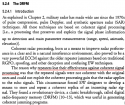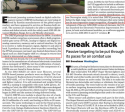You cannot store signal information on the threat library itself. Threat library contains different signal information but it is written on Read Only Memory, or ROM. Do you know what a ROM is?
In order to do a bit to bit comparison between the signals, you have to capture the threat signal and store it in memory, which is DRFM. It is the same way as if you are collecting notes and information and you have to write it on some scratch pad. That scratch pad is your DRFM. The notes you have written is then compared to the threat library. ESM uses a lot of these, as it is needed to store a lot of ambient signals it collected, and then compare these signals to every entry in the threat library for a positive.
Modern monopulse radars using pulse compression and phase coherency techniques, which means just about every current modern radar working on the planet today, would use DRFM to store a copy of the waveform it emits, and then compare the echoes to the stored copy. It will only accept signals that are close to that stored copy within certain parameters, which is determined through coherent processing.
In order to jam or spoof monopulse radars using such, the spoofer needs to capture and store the threat signal into DRFM, then alter it which is called range gating or velocity gating, which will fool the threat radar with false information. The spoof signal looks sufficiently similar to the copy stored by the threat monopulse radar that the radar accepts it as a valid echo, yet the waveform is altered to give the threat radar false information about the target's range and velocity.
The one possible way the threat radar can beat DRFM spoofing techniques with range or velocity gating is even tighter phase coherency algorithms.
If you are in SIGINT, your use of DRFM is a bit different since your main mission is to collect data, namely previous undocumented forms of threat signals that you can add to your library. If you are certain the signal is a threat waveform, but it does not match to any entry in your threat library, it remains stored in the DRFM for post mission analysis and potential inclusion to the threat library once it is properly identified.
DRFMs are used in radars. They are also used with cellular communications. In cellular communications, a base station needs to remember all the waveforms by all the cellphones within its range. That's like a teacher being able to remember the faces and voices of each student in the class. As time goes on, the students in the class change, the teacher has to remember the faces and voices of the new ones and where they are seating, as the new information displaces and is written over the memory of the previous pupil. So these things are as common as you can find in your phones, base stations and more sophisticated wifi units.
View attachment 56327 View attachment 56329








